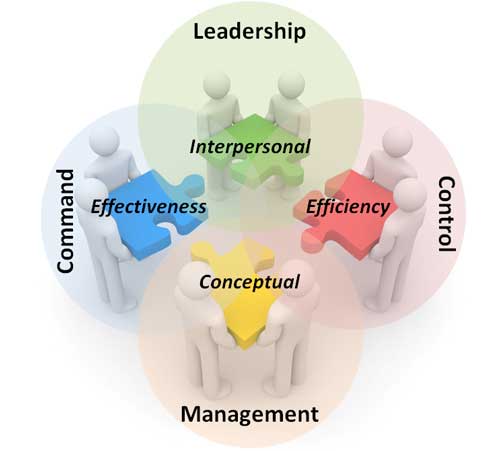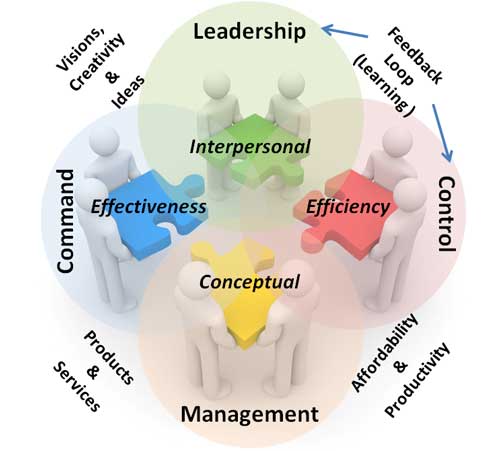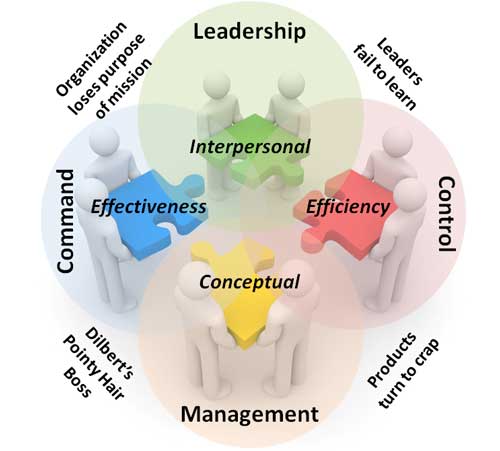Leadership, Management, Command, & Control
While there are plenty of discussions about leadership verses management and the need for command and control nowadays, these are important concepts that every leader must be aware of to successfully guide their organization. In fact, they are the four pillars of every organization as they directly drive the organization. Used properly, the business will grow; used improperly, the business will sink.These are not distinct processes, but rather concepts that all leaders perform in order to build and strengthen their organizations.

- Leadership drives the interpersonal aspects of the organization, such as moral and team spirit.
- Management deals with the conceptual issues of the organization, such as planning and organizing.
- Command guides the organization with well thought-out visions that makes it effective.
- Control provides structure to the organization in order to make it more efficient.
Benefits of the Four Processes

Command and Control
While most people think of command as simply telling others what to do, it goes far beyond that. Command is the imparting of a vision to the organization in order to achieve and end-goal. It does this by formulating a well-thought out vision and then clearly communicating it. Command emphasizes success and reward. That is, the organization has to be successful to survive and in turn reward its members (both intrinsically and extrinsically).An example would be visioning a process that helps to increase informal learning and make it more effective. A bad vision would be implementing a social media tool, such as a wiki or Twitter. This is because social media tools are the means rather than an end-goal. That is, they are more like specific objectives that enable you to achieve your end-goal (vision).
Now you might implement a social media tool as explained below, but the real goal is to increase interactions that lead to informal learning, while a supporting process is the tool itself.
Visions do not have to come from the top, but rather anywhere within the organization. Informal leaders are often good sources of visions; however, if the vision requires resources, then they normally need the support of a formal leader.
In contrast, Control is the process used to establish and provide structure in order to deal with uncertainties. Visions normally produce change, which in turn produce tension. These uncertainties cause tensions that leaders must deal with so they do not impede the organization. This is far different from most people's conception in which they think of control as controlling others.
For example, an organization might implement a new social media tool to enable its worker to interact with others and aid the process of informal learning more effectively. After implementing the tool the leader might ask, “Is the tool we provided to increase the effectiveness of informal learning really working?” Thus, control is also used to measure and evaluate.
Inherent in evaluation is efficiency—the act of examining the new tool often leads to processes that make it more efficient. This can be good because it can save money and often improve a tool or process. The danger of this is if the command process is weak and the control process is strong then it can make efficiency the end-goal. That is, it replaces effectiveness with efficiency.
A good example of this is our present economy that caused many organizations to perform massive layoffs. Now the very same organizations are complaining that they cannot find qualified workers. Efficiency over road effectiveness—they failed to realize that they would need a trained workforce in the future.
Leadership and Management
Management's primary focus is on the conceptual side of the business, such as planning, organizing, and budgeting. It does the leg work to make visions reality. Do NOT equate the term “management" with “controlling people." Management is more about ensuring that the organization's resources are allocated wisely, rather than trying to control people. In fact, good managers know that trying to control others is extremely difficult if not impossible.Management helps to acquire, integrate, and allocate resources in order to accomplish goals and task. Going back to the above example of increasing informal learning by implementing a new social media tool, the managers must look at the real goal, rather than the tool. The real goal is to increase informal learning and human interactions in order to make them more effective, not to put into place a media tool.
If the tool becomes the primary goal, then the wrong polices could be put into place that decrease its value as an informal learning tool, for example, implementing a policy that no one in the company can ask a question on Twitter as it might make us look stupid or our competitors will know what we are trying to do. This policy removes the real purpose of the tool—enabling the employees to learn informally from each other.
Secondly, if the focus is only on the tool, then other options are omitted, such as tearing down cubicles and creating spaces where people can meet.
In contrast, Leadership deals with the interpersonal relations such as being a teacher and coach, instilling organizational spirit to win, and serving the organization and workers.
The Synergy of the Four Pillars
While all four processes have their place, they are not implemented separately, but rather in concert. Using the example of implementing a new social media tool for increasing informal learning:- Command communicates the vision or goal to the best people who can implement it. Throughout the process, it adjusts to new knowledge and refines the vision.
- Management allocates the resources and helps to organize the activities that will make it a reality. This is normally a continuous process, rather than a single activity.
- Leadership helps to guide, coach, and motivate the people to do their best throughout the entire process.
- Control looks for opportunities to reduce risks, which in turn makes the process more efficient.

Likewise, if any of the pillars become too weak, it drives the organization out of balance:

Thus, the four pillars must consistently be weighed against each other to ensure they are in a proper balance that allows the organization to grow and prosper.